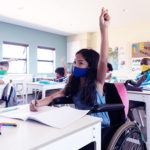Sending kids to school with celiac disease: One mom shares her story

As a neonatologist, it’s my job to understand and treat babies who need critical care. But as a mom whose two children live with celiac disease, it’s my job to find people who understand their specific medical needs and will advocate for them as much as possible. That’s why I’m so grateful for the Celiac Disease Program at Boston Children’s Hospital.
Navigating celiac disease for our children requires being proactive, which means understanding their diets and environments to minimize potential risks. Thanks to Dr. Dascha Weir, clinical director; Vanessa Weisbrod, director of education and community engagement; and the entire celiac program team, my husband and I truly feel empowered to help Emmett and Adeline lead a happy, healthy childhood despite the limitations celiac disease can impose. Now, our hope is to help other parents and caregivers in similar situation.
With that in mind, here are a few lessons we’ve learned:
Push for answers.
As a parent, you know your child the best.
Our son, Emmett, was 5 when he became tired frequently, complained of joint pain, and showed signs of anemia.
It took over a year to get answers. We were frequently told his pain was due to a “growth spurt” and his fatigue was from being an active kid, but I knew it was more than that. He just wasn’t himself, so we kept pushing for answers.
Eventually, Emmett had bloodwork drawn that showed signs consistent with celiac disease. That’s when everything changed.
It takes a village. Find yours.
To confirm a diagnosis of celiac disease, Emmett needed an endoscopy.
I asked my friend who’s a gastroenterologist who she would see in our situation. Without pause she said, “You have to see Dr. Weir at Boston Children’s.”
From the moment we met with Dr. Weir and Vanessa, we knew we had found our team.
We had reservations about bringing Emmett to the hospital for the endoscopy due to COVID-19 and general concerns about his anxiety, but right away the team was in touch to help us through the process. We spoke with a child-life specialist ahead of the procedure to discuss ways to make Emmett’s experience as easy as possible, including having Legos and art supplies — a few of his favorite things — laid on the bed when he arrived. Such a small gesture really helped lessen his anxiety.
Dr. Weir and the team have become more than just clinical support for us. They have become our allies. Dr. Weir has a fantastic bedside manner, is incredibly supportive, and goes above and beyond to make herself available. As a physician mom, I understand how challenging scheduling can be, but somehow, she and the team always fit us in.
Be proactive.
After we received the diagnosis of Emmett’s celiac disease, the team recommended that his younger sister daughter, Adeline, also be tested. Unbelievably — given she showed no symptoms — Adeline tested positive for celiac. Although she has a much milder case, we learned it could have easily become more acute when she got older, so we feel fortunate to have received her diagnosis when we did.
As celiac disease is an intolerance to gluten — a protein found in wheat, barley, rye, and oats — we immediately became a gluten-free family. However, a big part of navigating celiac disease is looking at each and every one of your environments beyond just your home: at friends’ houses, birthday parties, and especially school.
Because of this, the team recommended a 504 plan for Emmett.
Get the facts.
Celiac disease is covered under section 504(a) of the Rehabilitation Act of 1973, which prohibits discrimination on the basis of disability — including disease — in institutions that receive federal funding. The law requires federally funded schools to remove barriers to learning; this can mean accommodating a child’s gluten-free diet.
For Emmett, a 504 plan entails precautions such as having his own playdough and paper-mâché since regular formulas contain gluten. It also ensures that his school offers safe food choices or provides us with an opportunity to supply these items ourselves.
With Emmett, the process of setting up a 504 was somewhat intimidating, but Vanessa walked us through every step of the way. Thanks to her, we’re more prepared to help Adeline as she starts kindergarten this fall by working with the school nurse, the assistant principal, and her teacher.
Help your kids be kids.
Since working with Dr. Weir and the team and adjusting our lifestyle over the last six months, we’ve seen such a difference in Emmett’s overall energy. He no longer naps after school and has stopped complaining of joint pain. He’s a much happier child, and I have to think it’s because he’s feeling so much better. He’s playing tennis, skateboarding, and swimming and is very into science. And Adeline? She loves anything her brother loves. We’re grateful for it all — even the messy science experiments that are all around our house.
Learn more about attending school safely with celiac disease – including how to set up a 504 plan – with a free, virtual informational session hosted the Boston Children’s Hospital Celiac Disease Program. Register here.
Related Posts :
-

Athletes and fatigue: Why am I so tired?
Working out can boost physical and mental energy. Yet sometimes, athletes feel more fatigued than energized. "Feeling tired after a ...
-

New research sheds light on risk of gluten exposure in the kitchen and classroom
Parents and teachers typically go to great lengths in the kitchen and in the classroom to ensure children with Celiac ...
-

Taming reentry anxiety: How to prepare kids for a back-to-school like no other
After more than a year and a half of remote, hybrid, and home-schooling, it’s time to gear up for ...
-

Team spirit: How working with an allergy psychologist got Amber back to cheering
A bubbly high schooler with lots of friends and a passion for competitive cheerleading: On the surface, Amber’s life ...





